Objective 3. Create and Modify Lists
Word displays lists of information in two ways. A bulleted list uses bullets, which are text symbols such as small circles or check marks, to introduce each piece of information. Numbered lists use consecutive numbers to introduce each item in a list. Use bulleted lists when the items in the list can be displayed in any order; use numbered lists for items that have definite steps, a sequence of actions, or are in chronological order.
Activity 2.13. Creating a Bulleted List
|
1. |
Locate the paragraph that begins Trip to Portage Glacier and click to position the insertion point at the beginning of that paragraph. |
|
2. |
Scroll down until you can see the paragraph that begins Day in Fairbanks, hold down |
|
3. |
On the Formatting toolbar, click the Line Spacing button arrow |
|
4. |
On the Formatting toolbar, click the Bullets button Figure 2.28. (This item is displayed on page 344 in the print version) 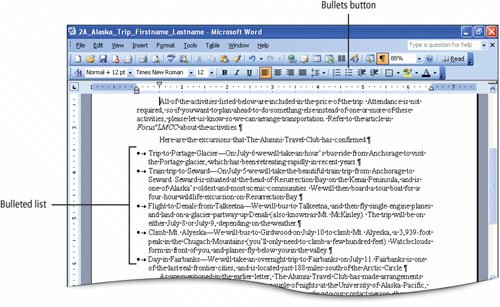
The selected text is changed to a bulleted list, as shown in Figure 2.28. The default bullet is a large, round, black dot. Your bullet symbols may differ, depending on which bullets were used last on your computer. |
|
|
|
|
5. |
Position the insertion point in the last bulleted point, which begins Day in Fairbanks. From the Format menu, display the Paragraph dialog box, and then under Spacing, in the After box, click the up spin arrow one time to change the value in the box from 0 pt to 6 pt. Click OK. |
|
6. |
Save |
Activity 2.14. Using AutoFormat to Create a Numbered List
In the previous activity, you created a list using existing text. In this activity you will create a new list and number the items using Word's Numbering command.
|
1. |
Press |
|
2. |
From the Tools menu, click AutoCorrect Options, and then click the AutoFormat As You Type tab. |
|
|
|
|
3. |
Under Apply as you type, check to see if the Automatic numbered lists check box is selected. Select it if necessary, and then compare your dialog box with Figure 2.29. Your selected check boxes may be different. Figure 2.29. 
|
|
4. |
Click OK to close the dialog box. Type 1. Honolulu and press |
|
|
|
|
5. |
Click the AutoCorrect Options button arrow Figure 2.30. 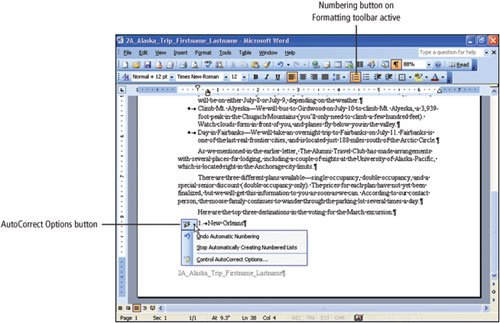
From the displayed list, you can remove the automatic formatting in this instance, or stop using the Automatic numbered lists option in this document. You also have the option to open the AutoCorrect dialog box. |
|
6. |
Click the AutoCorrect Options button to close the AutoCorrect Options menu without selecting any of the commands. Type San Francisco and press |
|
7. |
Type San Antonio and press |
|
8. |
On the Formatting toolbar, click the Numbering button More Knowledge: Continuous Numbering in a Series of Numbered Lists If you have a numbered list that is divided into several sections in different parts of a document, you can have Word number the items sequentially from one list to the next. Create the first list as described in this activity. When you create a second list later in the document, from the Format menu, click Bullets and Numbering. Be sure the Numbered tab is selected, and then click the Continue previous list option button. Alternatively, click the displayed AutoCorrect smart tag and click Continuous Numbering. |
|
9. |
Compare your document with Figure 2.31, and then Save Figure 2.31. 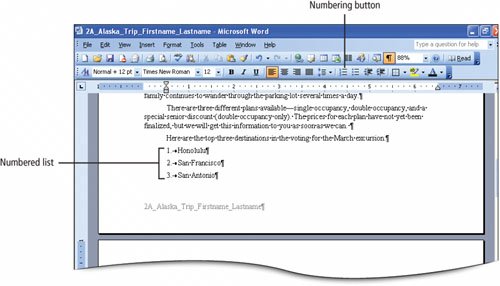
|
Activity 2.15. Formatting Lists
Each item in a list is a separate paragraph and can be formatted in the same way other paragraphs are formatted.
|
1. |
From the left margin area, point |
|
2. |
From the Format menu, display the Paragraph dialog box, and then click the Indents and Spacing tab. Under Spacing, in the After box, click the down spin arrow one time to set the space after the paragraphs to 0. Click OK to close the dialog box. |
|
3. |
On the Formatting toolbar, click the Decrease Indent button Figure 2.32. 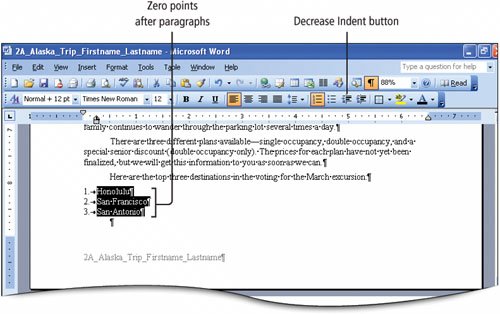
|
|
4. |
On the Formatting toolbar, click the Increase Indent button |
|
5. |
On the Formatting toolbar, click the Increase Indent button |
|
6. |
Save |
More Knowledge: Using Multiple Levels in a Numbered List
If your numbered list contains two levels of information, type all of the list entries using automatic numbering. When you have completed the list, select the items that are at the lower level and click the Increase Indent button. The top level will retain the 1, 2, 3 format, while the lower level will use an a, b, c format.
Activity 2.16. Customizing Bullets
You are not restricted to the bullet symbol that displays when you click the Bullets button. You can use any symbol from any font on your computer for your bullet character.
|
1. |
Scroll up until you can see all of the items in the bulleted list. From the margin area, use the |
|
2. |
From the Format menu, click Bullets and Numbering, and then compare your screen with Figure 2.33. Figure 2.33. 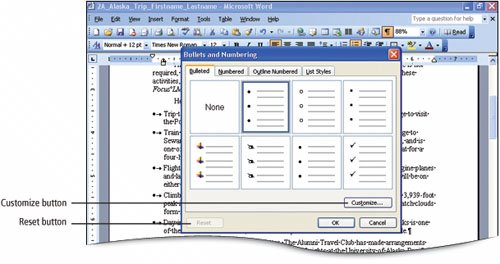
The Bullets and Numbering dialog box displays, displaying the most recently used bullets. Because the bullets displayed depend upon previous use at the computer at which you are seated, your screen may vary somewhat from Figure 2.33. If the default settings are active, the Reset button will be gray. |
|
3. |
In the Bullets and Numbering dialog box, in the lower left corner, click the Reset button (if it is not gray) to reset the default bulletsif a message displays, click Yes. Near the lower right corner, click the Customize button, and then compare your screen with Figure 2.34. Figure 2.34. 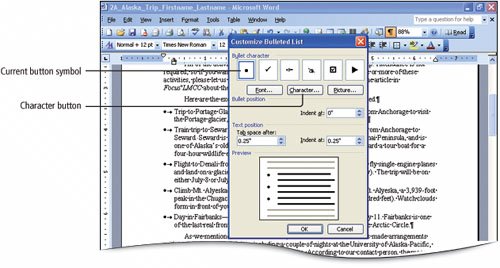
The Customize Bulleted List dialog box displays, showing the options that are available for customizing a bullet character. |
|
4. |
Under Bullet character, click the Character command button. |
|
5. |
At the top of the dialog box, click the Font arrow, scroll as necessary, and then click Wingdings. |
|
6. |
Use the scroll bar on the right of the dialog box to scroll down the list of Wingding characters until you reach the end. In the last row, click the check markthe fourth from the last character in the row, as shown in Figure 2.35. Figure 2.35. 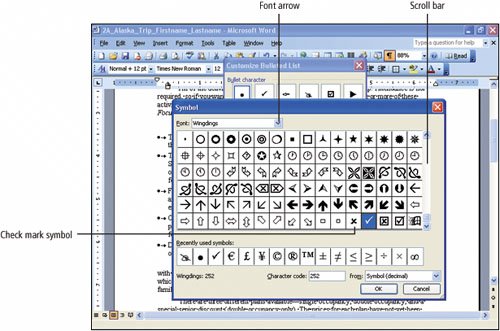
|
|
7. |
Click OK to close the Symbol dialog box. Click OK again to close the Customize Bulleted List dialog box. |
|
8. |
From the left margin area, using the |
|
|
|
|
9. |
Click anywhere in the document to deselect the list and compare your screen with Figure 2.36. Figure 2.36. 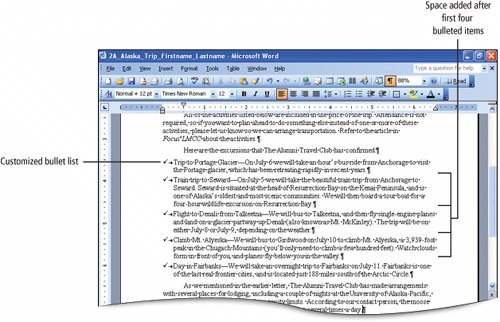
|
|
10. |
On the Standard toolbar, click the Print Preview button to make a final check of your document. Check your Chapter Assignment Sheet or Course Syllabus or consult your instructor to determine if you are to submit your assignments on paper or electronically. To submit electronically, go to Step 12, and then follow the instructions provided by your instructor. |
|
11. |
Close the Print Preview, and then on the Standard toolbar, click the Print button and submit your printout as directed. |
|
12. |
From the File menu, click Close, saving any changes if prompted to do so. Close |
|
End |
You have completed Project 2A |
Project 2B Research Paper |
Windows XP
- Chapter One. Getting Started with Windows XP
- Project 1A. Windows XP
- Objective 1. Get Started with Windows XP
- Objective 2. Resize, Move, and Scroll Windows
- Objective 3. Maximize, Restore, Minimize, and Close a Window
- Objective 4. Create a New Folder
- Objective 5. Copy, Move, Rename, and Delete Files
- Objective 6. Find Files and Folders
- Objective 7. Compress Files
- Summary
- Key Terms
- Concepts Assessments
Outlook 2003
- Chapter One. Getting Started with Outlook 2003
- Getting Started with Microsoft Office Outlook 2003
- Project 1A. Exploring Outlook 2003
- Objective 1. Start and Navigate Outlook
- Objective 2. Read and Respond to E-mail
- Objective 3. Store Contact and Task Information
- Objective 4. Work with the Calendar
- Objective 5. Delete Outlook Information and Close Outlook
- Summary
- Key Terms
- Concepts Assessments
- Skill Assessments
- Performance Assessments
- Mastery Assessments
- Problem Solving
- GO! with Help
Internet Explorer
- Chapter One. Getting Started with Internet Explorer
- Getting Started with Internet Explorer 6.0
- Project 1A. College and Career Information
- Objective 1. Start Internet Explorer and Identify Screen Elements
- Objective 2. Navigate the Internet
- Objective 3. Create and Manage Favorites
- Objective 4. Search the Internet
- Objective 5. Save and Print Web Pages
- Summary
- Key Terms
- Concepts Assessments
- Skill Assessments
- Performance Assessments
- Mastery Assessments
- Problem Solving
Computer Concepts
- Chapter One. Basic Computer Concepts
- Objective 1. Define Computer and Identify the Four Basic Computing Functions
- Objective 2. Identify the Different Types of Computers
- Objective 3. Describe Hardware Devices and Their Uses
- Objective 4. Identify Types of Software and Their Uses
- Objective 5. Describe Networks and Define Network Terms
- Objective 6. Identify Safe Computing Practices
- Summary
- In this Chapter You Learned How to
- Key Terms
- Concepts Assessments
Word 2003
Chapter One. Creating Documents with Microsoft Word 2003
- Chapter One. Creating Documents with Microsoft Word 2003
- Getting Started with Microsoft Office Word 2003
- Project 1A. Thank You Letter
- Objective 1. Create and Save a New Document
- Objective 2. Edit Text
- Objective 3. Select, Delete, and Format Text
- Objective 4. Create Footers and Print Documents
- Project 1B. Party Themes
- Objective 5. Navigate the Word Window
- Objective 6. Add a Graphic to a Document
- Objective 7. Use the Spelling and Grammar Checker
- Objective 8. Preview and Print Documents, Close a Document, and Close Word
- Objective 9. Use the Microsoft Help System
- Summary
- Key Terms
- Concepts Assessments
- Skill Assessments
- Performance Assessments
- Mastery Assessments
- Problem Solving
- You and GO!
- Business Running Case
- GO! with Help
Chapter Two. Formatting and Organizing Text
- Formatting and Organizing Text
- Project 2A. Alaska Trip
- Objective 1. Change Document and Paragraph Layout
- Objective 2. Change and Reorganize Text
- Objective 3. Create and Modify Lists
- Project 2B. Research Paper
- Objective 4. Insert and Format Headers and Footers
- Objective 5. Insert Frequently Used Text
- Objective 6. Insert and Format References
- Summary
- Key Terms
- Concepts Assessments
- Skill Assessments
- Performance Assessments
- Mastery Assessments
- Problem Solving
- You and GO!
- Business Running Case
- GO! with Help
Chapter Three. Using Graphics and Tables
- Using Graphics and Tables
- Project 3A. Job Opportunities
- Objective 1. Insert and Modify Clip Art and Pictures
- Objective 2. Use the Drawing Toolbar
- Project 3B. Park Changes
- Objective 3. Set Tab Stops
- Objective 4. Create a Table
- Objective 5. Format a Table
- Objective 6. Create a Table from Existing Text
- Summary
- Key Terms
- Concepts Assessments
- Skill Assessments
- Performance Assessments
- Mastery Assessments
- Problem Solving
- You and GO!
- Business Running Case
- GO! with Help
Chapter Four. Using Special Document Formats, Columns, and Mail Merge
- Using Special Document Formats, Columns, and Mail Merge
- Project 4A. Garden Newsletter
- Objective 1. Create a Decorative Title
- Objective 2. Create Multicolumn Documents
- Objective 3. Add Special Paragraph Formatting
- Objective 4. Use Special Character Formats
- Project 4B. Water Matters
- Objective 5. Insert Hyperlinks
- Objective 6. Preview and Save a Document as a Web Page
- Project 4C. Recreation Ideas
- Objective 7. Locate Supporting Information
- Objective 8. Find Objects with the Select Browse Object Button
- Project 4D. Mailing Labels
- Objective 9. Create Labels Using the Mail Merge Wizard
- Summary
- Key Terms
- Concepts Assessments
- Skill Assessments
- Performance Assessments
- Mastery Assessments
- Problem Solving
- You and GO!
- Business Running Case
- GO! with Help
Excel 2003
Chapter One. Creating a Worksheet and Charting Data
- Creating a Worksheet and Charting Data
- Project 1A. Tableware
- Objective 1. Start Excel and Navigate a Workbook
- Objective 2. Select Parts of a Worksheet
- Objective 3. Enter and Edit Data in a Worksheet
- Objective 4. Construct a Formula and Use the Sum Function
- Objective 5. Format Data and Cells
- Objective 6. Chart Data
- Objective 7. Annotate a Chart
- Objective 8. Prepare a Worksheet for Printing
- Objective 9. Use the Excel Help System
- Project 1B. Gas Usage
- Objective 10. Open and Save an Existing Workbook
- Objective 11. Navigate and Rename Worksheets
- Objective 12. Enter Dates and Clear Formats
- Objective 13. Use a Summary Sheet
- Objective 14. Format Worksheets in a Workbook
- Summary
- Key Terms
- Concepts Assessments
- Skill Assessments
- Performance Assessments
- Mastery Assessments
- Problem Solving
- You and GO!
- Business Running Case
- GO! with Help
Chapter Two. Designing Effective Worksheets
- Designing Effective Worksheets
- Project 2A. Staff Schedule
- Objective 1. Use AutoFill to Fill a Pattern of Column and Row Titles
- Objective 2. Copy Text Using the Fill Handle
- Objective 3. Use AutoFormat
- Objective 4. View, Scroll, and Print Large Worksheets
- Project 2B. Inventory Value
- Objective 5. Design a Worksheet
- Objective 6. Copy Formulas
- Objective 7. Format Percents, Move Formulas, and Wrap Text
- Objective 8. Make Comparisons Using a Pie Chart
- Objective 9. Print a Chart on a Separate Worksheet
- Project 2C. Population Growth
- Objective 10. Design a Worksheet for What-If Analysis
- Objective 11. Perform What-If Analysis
- Objective 12. Compare Data with a Line Chart
- Summary
- Key Terms
- Concepts Assessments
- Skill Assessments
- Performance Assessments
- Mastery Assessments
- Problem Solving
- You and GO!
- Business Running Case
- GO! with Help
Chapter Three. Using Functions and Data Tables
- Using Functions and Data Tables
- Project 3A. Geography Lecture
- Objective 1. Use SUM, AVERAGE, MIN, and MAX Functions
- Objective 2. Use a Chart to Make Comparisons
- Project 3B. Lab Supervisors
- Objective 3. Use COUNTIF and IF Functions, and Apply Conditional Formatting
- Objective 4. Use a Date Function
- Project 3C. Loan Payment
- Objective 5. Use Financial Functions
- Objective 6. Use Goal Seek
- Objective 7. Create a Data Table
- Summary
- Key Terms
- Concepts Assessments
- Skill Assessments
- Performance Assessments
- Mastery Assessments
- Problem Solving
- You and GO!
- Business Running Case
- GO! with Help
Access 2003
Chapter One. Getting Started with Access Databases and Tables
- Getting Started with Access Databases and Tables
- Project 1A. Academic Departments
- Objective 1. Rename a Database
- Objective 2. Start Access, Open an Existing Database, and View Database Objects
- Project 1B. Fundraising
- Objective 3. Create a New Database
- Objective 4. Create a New Table
- Objective 5. Add Records to a Table
- Objective 6. Modify the Table Design
- Objective 7. Create Table Relationships
- Objective 8. Find and Edit Records in a Table
- Objective 9. Print a Table
- Objective 10. Close and Save a Database
- Objective 11. Use the Access Help System
- Summary
- Key Terms
- Concepts Assessments
- Skill Assessments
- Performance Assessments
- Mastery Assessments
- Problem Solving Assessments
- Problem Solving
- You and GO!
- Business Running Case
- GO! with Help
Chapter Two. Sort, Filter, and Query a Database
- Sort, Filter, and Query a Database
- Project 2A. Club Fundraiser
- Objective 1. Sort Records
- Objective 2. Filter Records
- Objective 3. Create a Select Query
- Objective 4. Open and Edit an Existing Query
- Objective 5. Sort Data in a Query
- Objective 6. Specify Text Criteria in a Query
- Objective 7. Print a Query
- Objective 8. Specify Numeric Criteria in a Query
- Objective 9. Use Compound Criteria
- Objective 10. Create a Query Based on More Than One Table
- Objective 11. Use Wildcards in a Query
- Objective 12. Use Calculated Fields in a Query
- Objective 13. Group Data and Calculate Statistics in a Query
- Summary
- Key Terms
- Concepts Assessments
- Skill Assessments
- Performance Assessments
- Mastery Assessments
- Problem Solving
- You and GO!
- Business Running Case
- GO! with Access Help
Chapter Three. Forms and Reports
- Forms and Reports
- Project 3A. Fundraiser
- Objective 1. Create an AutoForm
- Objective 2. Use a Form to Add and Delete Records
- Objective 3. Create a Form Using the Form Wizard
- Objective 4. Modify a Form
- Objective 5. Create an AutoReport
- Objective 6. Create a Report Using the Report Wizard
- Objective 7. Modify the Design of a Report
- Objective 8. Print a Report and Keep Data Together
- Summary
- Key Terms
- Concepts Assessments
- Skill Assessments
- Performance Assessments
- Mastery Assessments
- Problem Solving
- You and GO!
- Business Running Case
- GO! with Help
Powerpoint 2003
Chapter One. Getting Started with PowerPoint 2003
- Getting Started with PowerPoint 2003
- Project 1A. Expansion
- Objective 1. Start and Exit PowerPoint
- Objective 2. Edit a Presentation Using the Outline/Slides Pane
- Objective 3. Format and Edit a Presentation Using the Slide Pane
- Objective 4. View and Edit a Presentation in Slide Sorter View
- Objective 5. View a Slide Show
- Objective 6. Create Headers and Footers
- Objective 7. Print a Presentation
- Objective 8. Use PowerPoint Help
- Summary
- Key Terms
- Concepts Assessments
- Skill Assessments
- Performance Assessments
- Mastery Assessments
- Problem Solving
- You and GO!
- Business Running Case
- GO! with Help
Chapter Two. Creating a Presentation
- Creating a Presentation
- Project 2A. Teenagers
- Objective 1. Create a Presentation
- Objective 2. Modify Slides
- Project 2B. History
- Objective 3. Create a Presentation Using a Design Template
- Objective 4. Import Text from Word
- Objective 5. Move and Copy Text
- Summary
- Key Terms
- Concepts Assessments
- Skill Assessments
- Performance Assessments
- Mastery Assessments
- Problem Solving
- You and GO!
- Business Running Case
- GO! with Help
Chapter Three. Formatting a Presentation
- Project 3A. Emergency
- Objective 1. Format Slide Text
- Objective 2. Modify Placeholders
- Objective 3. Modify Slide Master Elements
- Objective 4. Insert Clip Art
- Project 3B. Volunteers
- Objective 5. Apply Bullets and Numbering
- Objective 6. Customize a Color Scheme
- Objective 7. Modify the Slide Background
- Objective 8. Apply an Animation Scheme
- Summary
- Key Terms
- Concepts Assessments
- Skill Assessments
- Performance Assessments
- Mastery Assessments
- Problem Solving
- You and GO!
- Business Running Case
- GO! with Help
Integrated Projects
Chapter One. Using Access Data with Other Office Applications
- Chapter One. Using Access Data with Other Office Applications
- Introduction
- Project 1A. Meeting Slides
- Objective 1. Export Access Data to Excel
- Objective 2. Create a Formula in Excel
- Objective 3. Create a Chart in Excel
- Objective 4. Copy Access Data into a Word Document
- Objective 5. Copy Excel Data into a Word Document
- Objective 6. Insert an Excel Chart into a PowerPoint Presentation
Chapter Two. Using Tables in Word and Excel
- Chapter Two. Using Tables in Word and Excel
- Introduction
- Project 2A. Meeting Notes
- Objective 1. Plan a Table in Word
- Objective 2. Enter Data and Format a Table in Word
- Objective 3. Create a Table in Word from Excel Data
- Objective 4. Create Excel Worksheet Data from a Word Table
Chapter Three. Using Excel as a Data Source in a Mail Merge
- Chapter Three. Using Excel as a Data Source in a Mail Merge
- Introduction
- Project 3A. Mailing Labels
- Objective 1. Prepare a Mail Merge Document as Mailing Labels
- Objective 2. Choose an Excel Worksheet as a Data Source
- Objective 3. Produce and Save Merged Mailing Labels
- Objective 4. Open a Saved Main Document for Mail Merge
Chapter Four. Linking Data in Office Documents
- Chapter Four. Linking Data in Office Documents
- Introduction
- Project 4A. Weekly Sales
- Objective 1. Insert and Link in Word an Excel Object
- Objective 2. Format an Object in Word
- Objective 3. Open a Word Document That Includes a Linked Object, and Update Links
Chapter Five. Creating Presentation Content from Office Documents
EAN: 2147483647
Pages: 448
- The Effects of an Enterprise Resource Planning System (ERP) Implementation on Job Characteristics – A Study using the Hackman and Oldham Job Characteristics Model
- Distributed Data Warehouse for Geo-spatial Services
- Intrinsic and Contextual Data Quality: The Effect of Media and Personal Involvement
- Healthcare Information: From Administrative to Practice Databases
- Relevance and Micro-Relevance for the Professional as Determinants of IT-Diffusion and IT-Use in Healthcare
 , and then click at the end of that paragraph. Be sure to include the paragraph mark at the end of the last paragraph.
, and then click at the end of that paragraph. Be sure to include the paragraph mark at the end of the last paragraph. and click 1.0 to single space the selected text. Scroll as necessary so that you can view all of the selected text on your screen.
and click 1.0 to single space the selected text. Scroll as necessary so that you can view all of the selected text on your screen. . If your bulleted list is indented, on the Formating toolbar, click the Decrease Indent button
. If your bulleted list is indented, on the Formating toolbar, click the Decrease Indent button  one time. Click anywhere in the document to deselect the text, and then compare your screen with Figure 2.28.
one time. Click anywhere in the document to deselect the text, and then compare your screen with Figure 2.28. your changes.
your changes. to move to the end of the document, and then press
to move to the end of the document, and then press  one time.
one time. , and then compare your screen with Figure 2.30.
, and then compare your screen with Figure 2.30. to turn off automatic numbering. Alternatively, press
to turn off automatic numbering. Alternatively, press  or
or  to the left of 1. and drag down to select the three numbered items.
to the left of 1. and drag down to select the three numbered items. .
. Word.
Word.